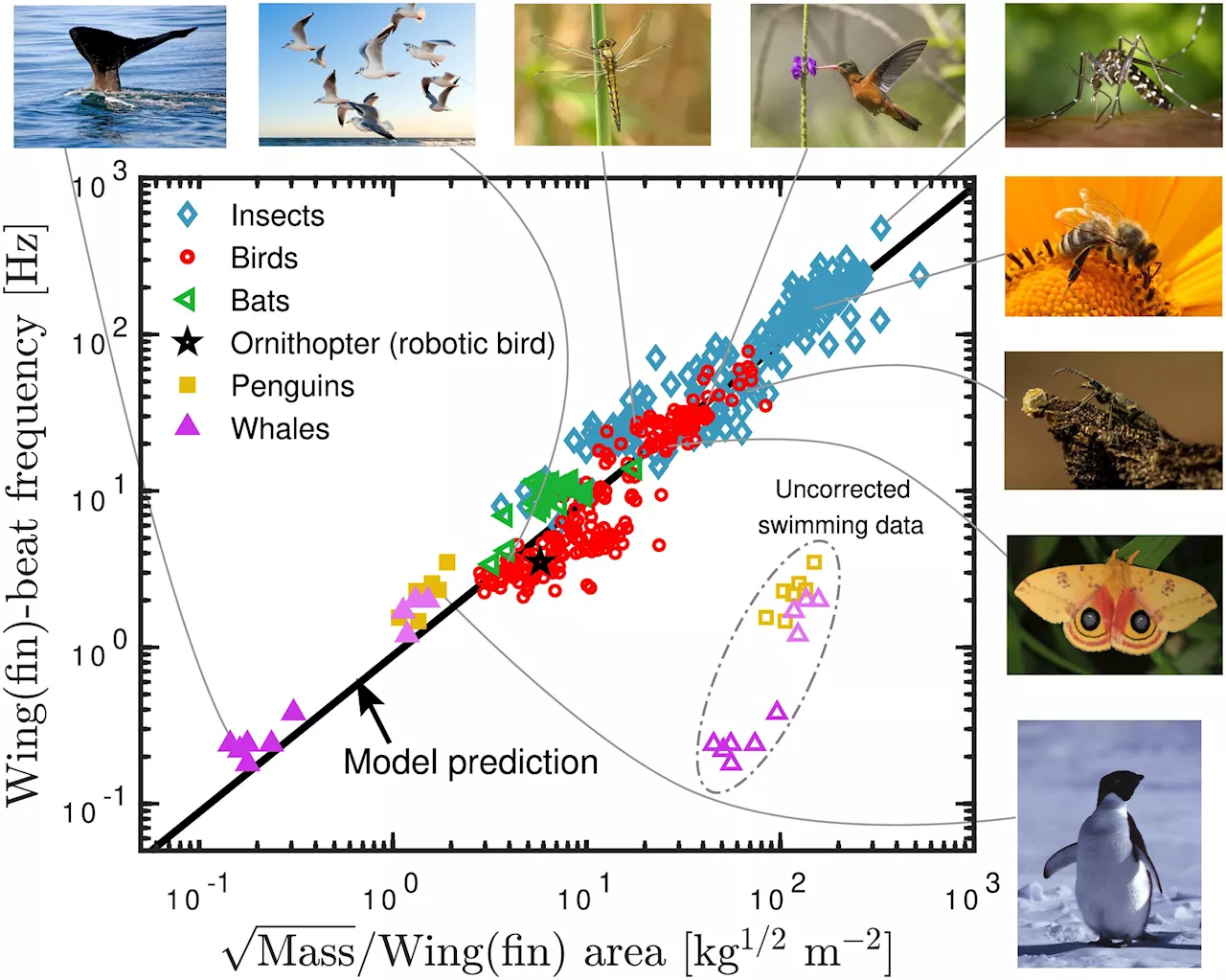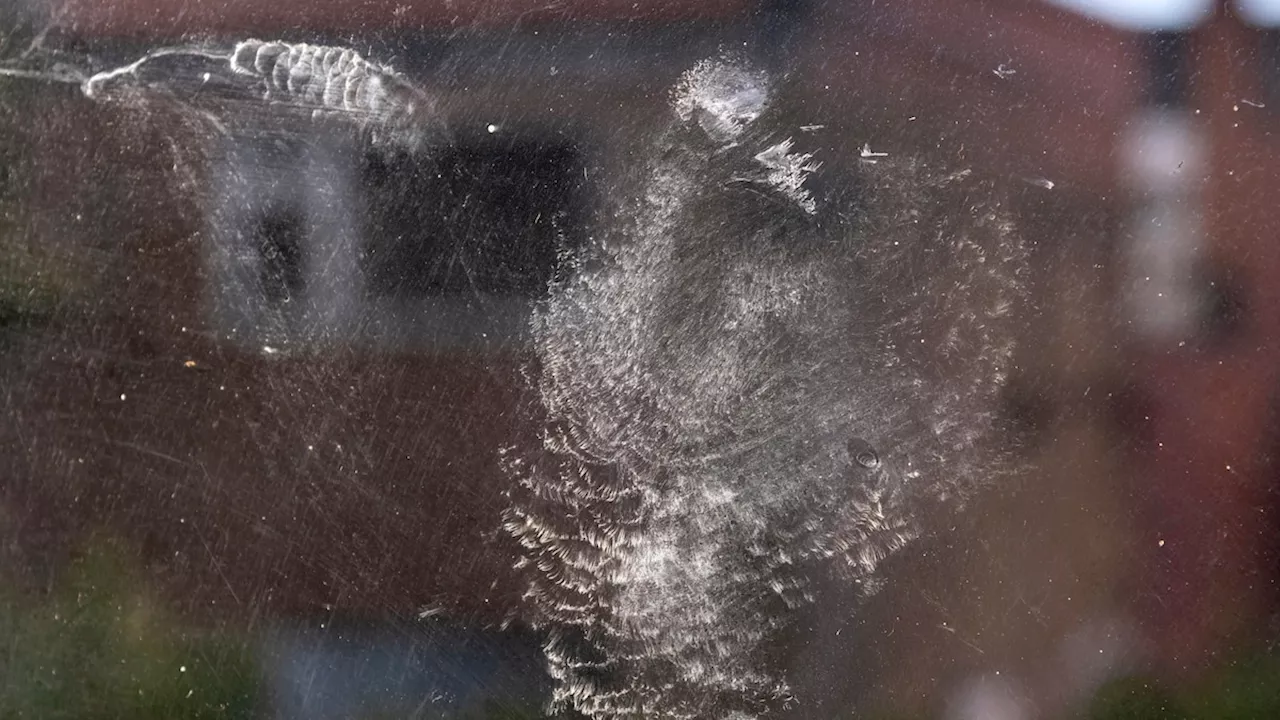A single universal equation can closely approximate the frequency of wingbeats and fin strokes made by birds, insects, bats and whales, despite their different body sizes and wing shapes, researchers report in a new study.
The wing and fin beats of flying and diving animals can be predicted using just body mass and wing area
They found that flying and diving animals beat their wings or fins at a frequency that is proportional to the square root of their body mass, divided by their wing area. They tested the accuracy of the equation by plotting its predictions against published data on wingbeat frequencies for bees, moths, dragonflies, beetles, mosquitos, bats, and birds ranging in size from hummingbirds to swans.
The study shows that despite huge physical differences, animals as distinct as butterflies and bats have evolved a relatively constant relationship between body mass, wing area and wingbeat frequency. The researchers note that for swimming animals they didn't find publications with all the required information; data from different publications was pieced together to make comparisons, and in some cases animal density was estimated based on other information.
After blue whales, fin whales are the largest whales in the world -- and human beings have hunted both species to near-extinction. After the ban on commercial whaling in 1976, the stocks of these ...
Birds Animals Wild Animals Information Technology Encryption Hacking Mathematics
Nigeria Latest News, Nigeria Headlines
Similar News:You can also read news stories similar to this one that we have collected from other news sources.
 Flapping frequency of birds, insects, bats and whales predicted with just body mass and wing areaA single universal equation can closely approximate the frequency of wingbeats and fin strokes made by birds, insects, bats and whales, despite their different body sizes and wing shapes, Jens Højgaard Jensen and colleagues from Roskilde University in Denmark report in a new study published in PLOS ONE on June 5.
Flapping frequency of birds, insects, bats and whales predicted with just body mass and wing areaA single universal equation can closely approximate the frequency of wingbeats and fin strokes made by birds, insects, bats and whales, despite their different body sizes and wing shapes, Jens Højgaard Jensen and colleagues from Roskilde University in Denmark report in a new study published in PLOS ONE on June 5.
Read more »
 New Dinosaur Fossil Tells The Story Of How Birds Took To The SkiesI am an American evolutionary biologist, based at Rutgers University, where I specialize in biodiversity, evolution, and genomics. Drop me a note, here. Thanks for your readership and support.
New Dinosaur Fossil Tells The Story Of How Birds Took To The SkiesI am an American evolutionary biologist, based at Rutgers University, where I specialize in biodiversity, evolution, and genomics. Drop me a note, here. Thanks for your readership and support.
Read more »
 Target's 2024 Pride Birds Has People Obsessed And They're Selling OutForget rainbow-themed merch; people want birds that are themed to Tippi Hedren in The Birds for Pride.
Target's 2024 Pride Birds Has People Obsessed And They're Selling OutForget rainbow-themed merch; people want birds that are themed to Tippi Hedren in The Birds for Pride.
Read more »
 This invisible killer takes out 3.5 billion U.S. birds a yearGlass is even more deadly to birds than previously thought, according to new research. But, unlike many environmental problems, scientists say the solutions are simple.
This invisible killer takes out 3.5 billion U.S. birds a yearGlass is even more deadly to birds than previously thought, according to new research. But, unlike many environmental problems, scientists say the solutions are simple.
Read more »
 Birds of Prey #10 Preview: Portal PandemoniumAh, nothing says 'we've run out of ideas' quite like spatial anomalies and unstable portals. But that's where we find ourselves in Birds of Prey 10, hitting stores on Tuesday, June 4th.
Birds of Prey #10 Preview: Portal PandemoniumAh, nothing says 'we've run out of ideas' quite like spatial anomalies and unstable portals. But that's where we find ourselves in Birds of Prey 10, hitting stores on Tuesday, June 4th.
Read more »
 Saturday Citations: The sound of music, sneaky birds, better training for LLMs. Plus: Diversity improves researchIn the small fishing village where I grew up, we didn't have much. But we helped our neighbors, raised our children to respect the sea, and embraced an inclusive scientific methodology with a cross section of sex, race and gender among study participants that enriched the results of our research.
Saturday Citations: The sound of music, sneaky birds, better training for LLMs. Plus: Diversity improves researchIn the small fishing village where I grew up, we didn't have much. But we helped our neighbors, raised our children to respect the sea, and embraced an inclusive scientific methodology with a cross section of sex, race and gender among study participants that enriched the results of our research.
Read more »
